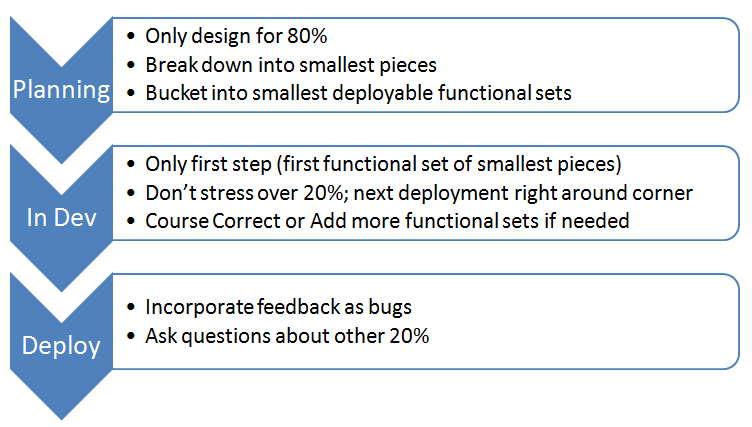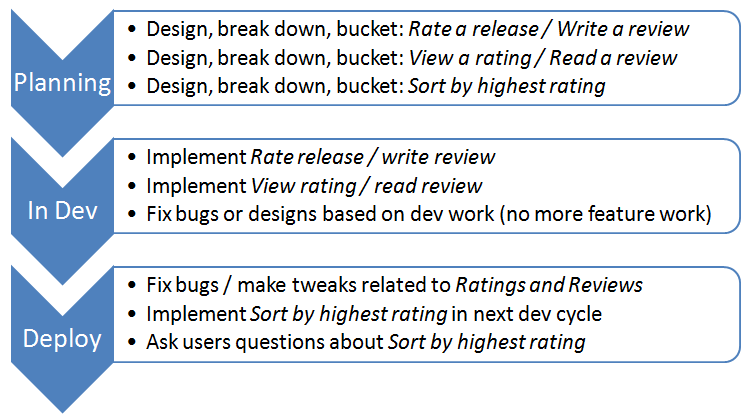Part 1: Lessons I Learned as a Project Manager Converting to Agile
by saraford on October 19, 2009 02:16pm
Before I became the Program Manager for CodePlex.com, Microsoft's open source project hosting site, I worked on the Visual Studio team on four different product cycles. Since Visual Studio uses traditional Microsoft product lifecycle releases, I had to learn about Agile development alongside learning about open source development when I joined the CodePlex.com team. Making the switch from releasing every three years to every three weeks didn't happen overnight!
One of the things I discovered is that Agile is used a lot in open source communities. In fact, many of the people who I've worked with personally on learning Agile have strong roots in OSS. Also, the fact that Microsoft is starting to adopt Agile philosophies shows how the company is changing, becoming more transparent, finding more ways to connect with the community, and embracing other schools of thought. And this is why I am here, to be on the inside to push for these cultural changes within Microsoft.
Although Agile is the single greatest thing a team could do to significantly improve the user experience and quality of their website, I believe it can be quite challenging for anyone not in a developer role to get accustomed to. I hope that by sharing my experiences, I can help others in non-developer disciplines on an Agile team.
In this series of blog posts, you'll discover how I learned to program manage an Agile team after six years of waterfall (the traditional method of software development).
Three Major Takeaways
If I could go back in time, here are the three things I would tell myself about Agile.
1. Design and plan for the very next step.
It's not about reaching the moon, but getting out of your front door. Sure, you can design the perfect feature, but if it is going to take you six months to get there, it is useless to an Agile team. It's about designing the journey towards the perfect feature that matters.
2. Break down work into the smallest possible functional sets.
Adding work is fun and rewarding, but removing incomplete work due to a lack of development time is painful and risky. But, you can't deploy a half-written feature either. First, break down the work into the smallest pieces. Then, put together the smallest functional sets that have to be deployed together for the feature to make sense. Your development team will tell you how many sets they can do per release.
3. Design and plan only 80% of the way.
Not designing the full 100% is a true blessing in disguise. Since you have another release right around the corner, you have the time to collect user feedback and incorporate it into the next design. Not only does this solve the remaining 20% (getting you closer to the perfect design with less cost), but also allows your customers to be virtual members of your team.
The Program Manager Release Cycle
To begin, here's an Agile release cycle from the point of view of the Program Manager. For simplicity, this illustration only depicts a single release cycle, without any overlap of previous or future cycles.

Ratings and Reviews: An Example
To further illustrate, consider the ratings and reviews feature on CodePlex.com as an example. Users can rate a release and write a review for projects on CodePlex.
One quick aside about ratings and reviews: CodePlex users rate an individual release instead the entire project. For example, consider Stephen King as an author. What does it mean for me to rate Stephen King 4 out of 5 stars? I find some of his books to be awful, like the Tommyknockers. I want those 7 hours of my life back. 1 out of 5 stars. Yet, for me, some of his other books are incredible, like The Dark Tower. 5 out of 5 stars. Hence, we allow users to rate an individual release to provide more relevant information to potential downloaders of the project.
Let's explore the ratings and reviews feature step-by-step in the Program Manager shoes.
1. Design Phase Part 1: Limit the scope to designing the minimum to make the feature useful and meaningful. For ratings and reviews, the feature must have the following:
a. User can rate a release. User can view the rating.
b. User can write a review. User can read the review.
c. User can sort by highest rated releases in project directory.
2. Design Phase Part 2: Bucket into smallest deployable functional sets. For me, personally, I use sticky notes to illustrate the "must have" pieces for each set.
a. Sticky Note #1: Rate releases / View rating
b. Sticky Note #2: Write a review / read review
c. Sticky Note #2: Sort by highest rated releases
3. Iteration Planning Meeting: To start the development cycle, meet with the development team to discuss costing.
a. In the case of ratings and reviews, my devs said they could do Sticky Notes #1 and #2, but the project directory sorting feature would have to wait for the next release.
4. Dev Cycle: Because the designs are closer to 1-page specifications rather than fully-documented implementations, questions will come up from the dev team. This is where you, the Program Manager, will:
a. Answer any questions about the missing 20% of the specifications / wireframes
b. "Course correct" (more on that later)
c. Add more feature work if time allows
5. Deployment: The release goes live. Now you can collect user feedback and incorporate it into the next development cycle.
a. The very first tweet I saw regarding the ratings and reviews feature was "Sara, is there a way to sort by highest rated?" Here, I was able to ask the user questions about how this feature should work to confirm our designs. Most of the time we don't inform users what's coming up next (we like surprises.) But in this case, it was pretty obvious.
Here's the visual representation of the ratings and reviews feature in the Program Management agile release cycle:

Conclusion of Part 1: The Agile Program Management Cycle
This concludes my first post on Program Managing an Agile team. Since I could go on endlessly writing about topics I'm passionate about (and those who know me will confirm this is not an exaggeration), I'm going to pause here to conclude this initial train of thought.
If you like what you see, let me know! And if you don't like what you see, please don't hesitate to let me know. Seriously, I love discussing my Love / Hate Relationship with Agile development, as depicted on my personal blog.
Up next: The concept of Course Correction.